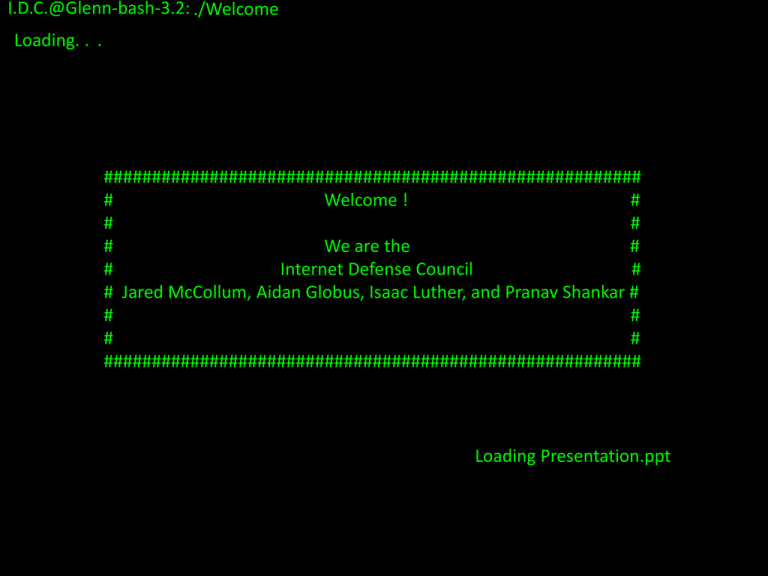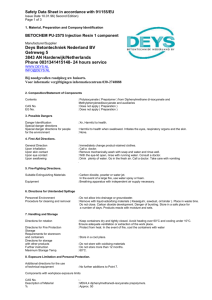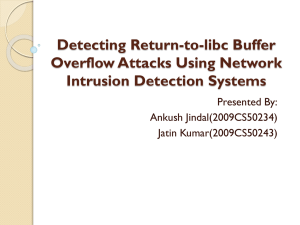NetworkingForensics_2012 (1)
advertisement

I.D.C.@Glenn-bash-3.2: ./Welcome Loading. . . ######################################################## # Welcome ! # # # # We are the # # Internet Defense Council # # Jared McCollum, Aidan Globus, Isaac Luther, and Pranav Shankar # # # # # ######################################################## Loading Presentation.ppt Ohio Supercomputer Center SI 2012 GROUP MEMBERS: Jared McCollum Isaac Luther Pranav Shankar Aidan Globus MENTORS: Dr. Prasad Calyam Arun Selvadhurai Dr. Marcio Faerman Our Organization Internet Defense Council Network Security Firm Intrusion Detection and Litigation Overview: Thunderbolt Games Client: Thunderbolt Games User passwords and credit card information hi-jacked Suspect: AccordionSoft, rival game company Hackers: Who are they? Hackers are people who attack computers or intercept data from servers for malicious purposes Why? Financial Gain Blackmail Vengeance SSL-Authentication Attack “Man-in-the-Middle” Attack Hacker hijacks User Data Bypasses nearly all site security Ping Flood Often from many computers Ping used for testing latency Huge amounts of pinging can slow a server and make it unusable Buffer Overflow Buffer is the window of space allotted for use in a computer Hackers use viruses to use more memory than the buffer can handle Often causes computer or server to crash SQL-Injection Executes malicious code with purposeful errors Allows access into the computer’s or server’s databases Network Security Tools Wireshark - monitors all information entering and leaving the computer Snort - detects intrusions into the system and logs them for further examination on servers AND networks http://www.wireshark.org/ http://www.snort.org/ Network Security Tools (cont.) Perl - programming language used for web development and interfacing with servers, files and databases MySQL - engine used for managing databases on a server or computer Goals Generate attack log identical to real log file Randomly select IP address from list Randomly select network protocol Randomly generate timestamps in chronological order Select attack type from uneven distribution based on country Select an IP address Select corresponding country Calculate threat level from frequency and attack type Print out to file Generate frequency, fluctuating differently depending on location Randomly select a protocol Country Originated From Destination IP Timestamp Source IP Protocol Attack Type Frequency Threat Level Parsing the Attack Log: Goals Compile the attack log into an organized list Calculate “Danger Level” of each entry Calculate the Threshold level Compile threats into a table Import tables into MySQL Plan • Load log file into our Perl code • Organize anomalies into a list • Modify Danger Level based upon certain parameters • Organize data into table • Upload table to MySQL database Part 1 Gather data from log file Put data into array Parse Data Display array in proper form IP Address Type of Attack Danger Level Explanation of the Danger Level • Wanted Danger Level to represent frequency, time, and logged Threat Level ((Frequency/Time) + Threat Level) • Danger Level = 2 • Allowed us to represent all “Danger” factors in one variable Part 2 1.Gather data from log file 4.Put data into array 3.Apply algorithm to remove false alarms 2.Parse Data with Threshold 2.5Get IP’s and look for repeats 5.Display array in proper form 6.Upload forms to database Explanation of the Threshold • Wanted to capture all entries that were above the average Danger Level • Used a confidence interval • Interval gave a range for the mean • Upper limit of the interval became our threshold Average Danger Level Standard Deviation Confidence Interval Output of our Code: • We imported certain data from the log file to MySQL and into this table • Listed IP, Type, and Danger Level • IP addresses differed among the processes • Contained 4 Types of attacks; SQL Injection, Buffer Overflow, SSL Authorization, and Ping Overflow Output of our Code: • We listed the anomalies in the attack log • These entries all had a Danger Level that was more than our Threshold • We registered 170 anomalies/threats to the system • We tracked through a series of CPU’s being used as botnets to find the IP address of the controller June 8th We traced the source IP addresses of the attacks to certain locations. We will now show you a demonstration illustrating where the attacks came from: Legend: = SSL Authentication = Ping Flood = Buffer Overflow = SQL Injection Map of all Attacks Throughout the 5 Days Legend: = SSL Authentication = Ping Flood = Buffer Overflow = SQL Injection • Successful project outcomes • Learned how to program in Perl • Learned how to use MySQL • Learned about general network security and forensics • Excellent communication Special Thanks to… Dr. Prasad Calyam Renea Colopy Dr. Marcio Faerman Arun Selvadhurai Dr. Alan Chalker Liz Hudak Liz Stong Dr. Ben Smith Zarius Shroff Thank you for your attention!











